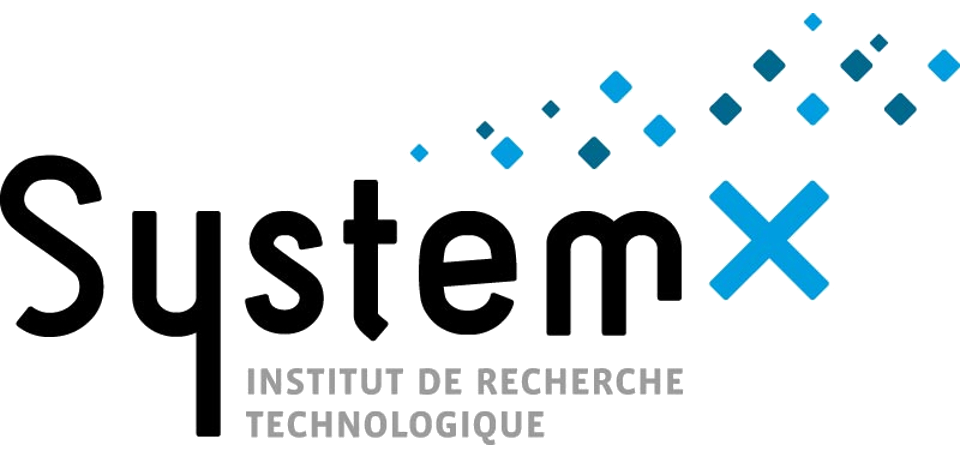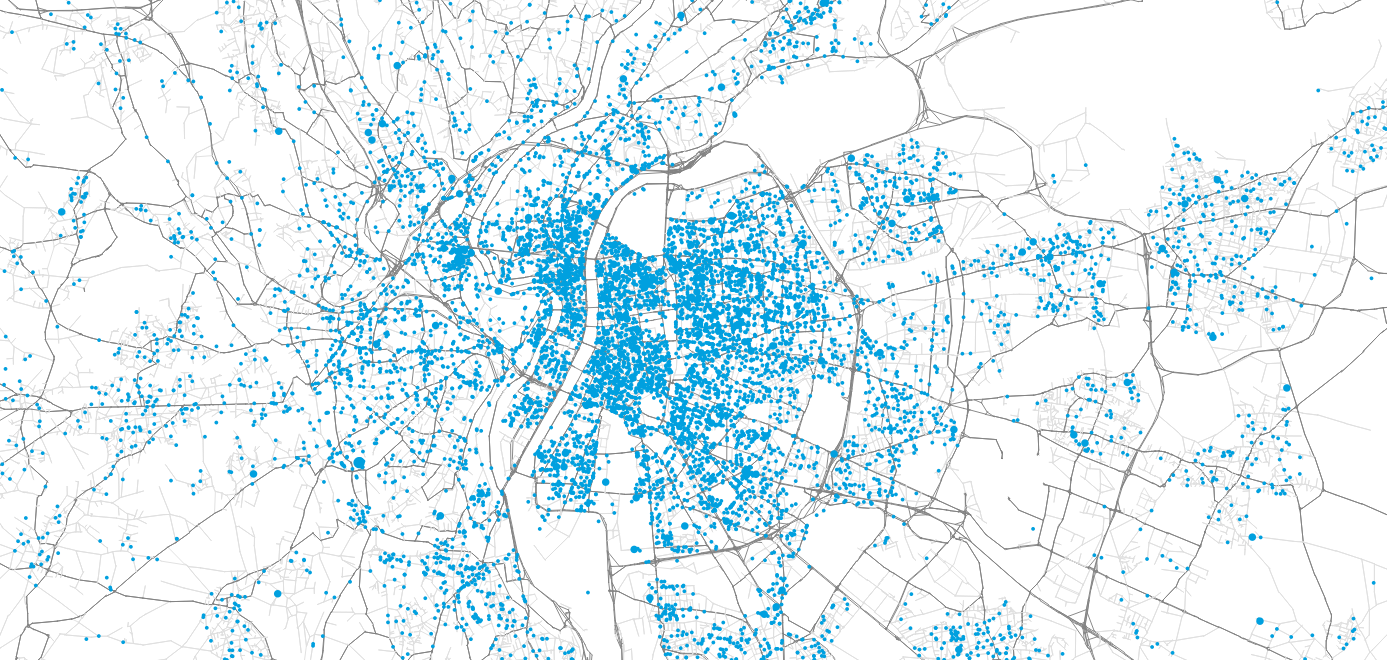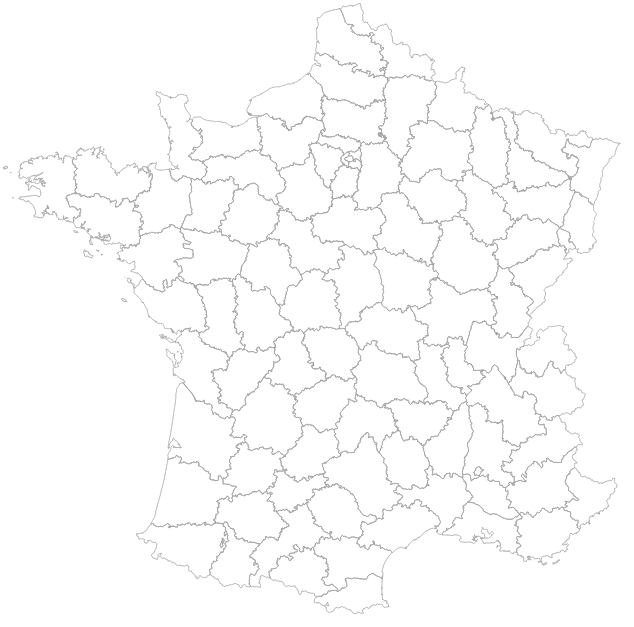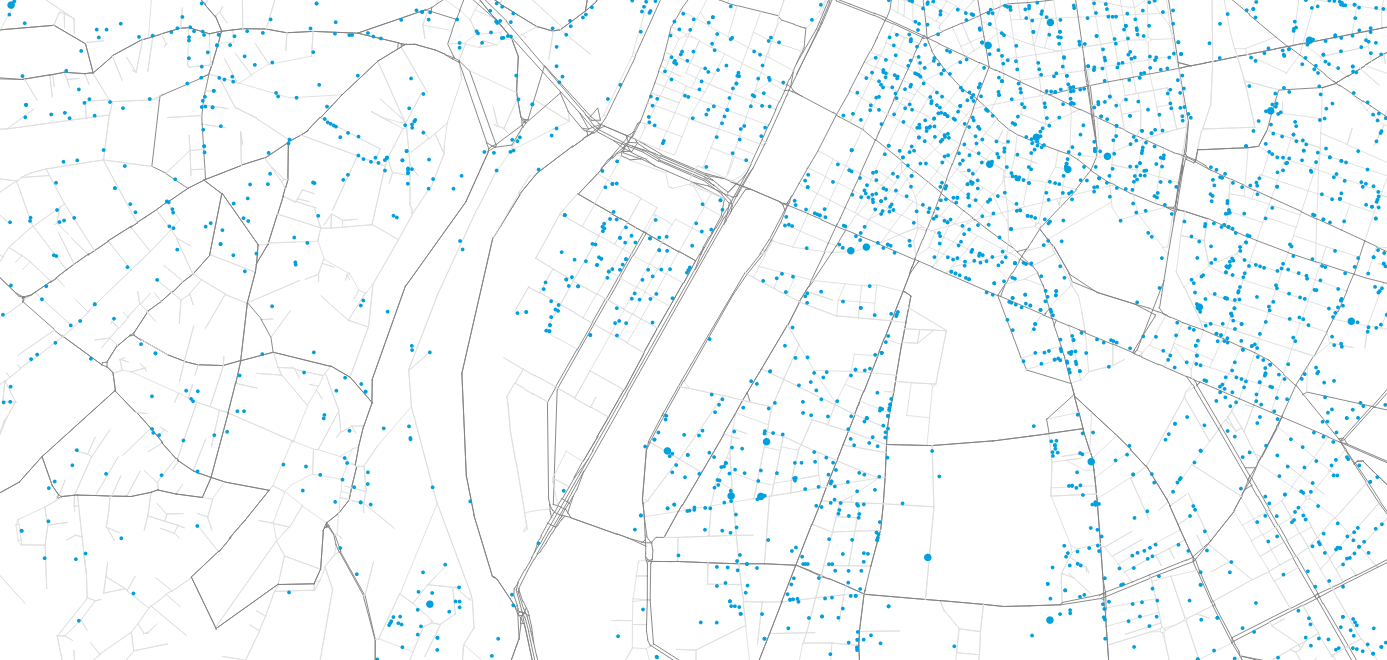


Estimating the impact of parcel deliveries using multiagent simulation
Sebastian Hörl
1 November 2021
Brown Bag IVT
IRT SystemX

- Public/private research institute situated in Paris
- Focus on fostering digital transition in a range of fields from transport, cybersecurity to circular economy
- Transferring research results and tools into active application by development and provision of industry platforms
- Various collaborative projects with multiple French companies (Renault, SNCF, ...) and academic partners (Université Paris Saclay, CentraleSupélec, Université Gustave Eiffel)
- Participation in European projects

MATSim @ IRT SystemX

- On-demand mobility simulation
- First/last mile mobility simulation
Passenger transport
Freight transport



- First/last mile delivery
- VRP Solvers
- Development of electric VRP for JSprit

MEMOLOG

Alliance pour la Modélisation et l’aide à l’Exploitation des systèmes de Mobilité et Logistique
- Research initiative with the goal to foster practical use of multiagent transport simulation for
- Passenger mobility
- Logistics
- Territorial development
- In close collaboration with industrial partners and specific real-world use cases
- Focus on standardization of formats and methods, multiscale simulation, verification, and real-time capabilities
- Start expected beginning of 2021 over a duration of 4 years with 3-4 PhD students jointly supervised by IRT SystemX and Université Gustave Eiffel


LEAD Project

Low-emission Adaptive last-mile logistics supporting on-demand economy through Digital Twins
- H2020 Project from 2020 to 2023
- Six living labs with different innovative logistics concepts
- Lyon, The Hague, Madrid, Budapest, Porto, Oslo
- One partner for implementation and one for research each
- Development of a generic modeling library for last-mile logistics scenario simulation and analysis

Lyon Living Lab

- Peninsula Confluence between Saône and Rhône
- Interesting use case as there are limited access points
- Implementation of an urban consolidation center (UCC) to collect the flow of goods and organize last-mile distribution
- using cargo-bikes
- using electric robots
- and others
- Analysis and modeling through
- Flow estimation through cameras
- Simulation of future scenarios
- Focus on parcel deliveries due to data availability


Modeling methodology

- Main question: What is the impact on traffic and population of implementing an Urban Consolidation Center in Confluence?
- Focus on B2C parcel deliveries due to data availability

Modeling methodology

Agent-based simulation of Lyon
- Main question: What is the impact on traffic and population of implementing an Urban Consolidation Center in Confluence?
- Focus on B2C parcel deliveries due to data availability

Modeling methodology


Agent-based simulation of Lyon
Demand in parcel deliveries
- Main question: What is the impact on traffic and population of implementing an Urban Consolidation Center in Confluence?
- Focus on B2C parcel deliveries due to data availability

Modeling methodology





Agent-based simulation of Lyon
Demand in parcel deliveries
Distribution by operators
- Main question: What is the impact on traffic and population of implementing an Urban Consolidation Center in Confluence?
- Focus on B2C parcel deliveries due to data availability

Modeling methodology






Agent-based simulation of Lyon
Demand in parcel deliveries
Distribution by operators
KPI Calculation
- Main question: What is the impact on traffic and population of implementing an Urban Consolidation Center in Confluence?
- Focus on B2C parcel deliveries due to data availability

Methodology: Agent-based models











0:00 - 8:00
08:30 - 17:00
17:30 - 0:00
0:00 - 9:00
10:00 - 17:30
17:45 - 21:00
22:00 - 0:00





- Discrete locations
- Individual travelers
- Individual behaviour
- Whole day analysis
Disaggregated
Icons on this and following slides: https://fontawesome.com



Population census (RP)

Income data (FiLoSoFi)

Commuting data (RP-MOB)
National HTS (ENTD)

Enterprise census (SIRENE)

OpenStreetMap

GTFS (SYTRAL / SNCF)

Address database (BD-TOPO)
Methodology: Synthetic travel demand


EDGT
Synthetic travel demand has been generated for Lyon in order to perform agent-based mobility simulation of all residents' movements.


Methodology: Synthetic travel demand
Open
Data


Open
Software
+
=
Reproducible research
Integrated testing

Population census (RP)

Income data (FiLoSoFi)

Commuting data (RP-MOB)
National HTS (ENTD)

Enterprise census (SIRENE)

OpenStreetMap

GTFS (SYTRAL / SNCF)

Address database (BD-TOPO)


EDGT
Synthetic travel demand has been generated for Lyon in order to perform agent-based mobility simulation of all residents' movements.


Methodology: Synthetic travel demand

Open
Software
=
Reproducible research
Integrated testing

Paper published July 2021
Open
Data


Open
Software
+
=
Reproducible research
Integrated testing

Population census (RP)

Income data (FiLoSoFi)

Commuting data (RP-MOB)
National HTS (ENTD)

Enterprise census (SIRENE)

OpenStreetMap

GTFS (SYTRAL / SNCF)

Address database (BD-TOPO)


EDGT
Synthetic travel demand has been generated for Lyon in order to perform agent-based mobility simulation of all residents' movements.


Methodology: Synthetic travel demand












Methodology: Parcel demand


Synthetic population

+
Synthetic population
Out-of-home purchase survey
Achats découplés des ménages

Based on sociodemographic attributes of the households, parcels are generated for the city on an average day.

Gardrat, M., 2019. Méthodologie d’enquête: le découplage de l’achat et de la récupération des marchandises par les ménages. LAET, Lyon, France.
Methodology: Parcel demand


Synthetic population

+
Synthetic population
Out-of-home purchase survey
Achats découplés des ménages

Based on sociodemographic attributes of the households, parcels are generated for the city on an average day.


Gardrat, M., 2019. Méthodologie d’enquête: le découplage de l’achat et de la récupération des marchandises par les ménages. LAET, Lyon, France.
Methodology: Parcel demand


Synthetic population

+
Synthetic population
Out-of-home purchase survey
Achats découplés des ménages

Based on sociodemographic attributes of the households, parcels are generated for the city on an average day.



Gardrat, M., 2019. Méthodologie d’enquête: le découplage de l’achat et de la récupération des marchandises par les ménages. LAET, Lyon, France.
Methodology: Parcel demand


Synthetic population

Gardrat, M., 2019. Méthodologie d’enquête: le découplage de l’achat et de la récupération des marchandises par les ménages. LAET, Lyon, France.
+
Synthetic population
Out-of-home purchase survey
Achats découplés des ménages

Based on sociodemographic attributes of the households, parcels are generated for the city on an average day.




Gardrat, M., 2019. Méthodologie d’enquête: le découplage de l’achat et de la récupération des marchandises par les ménages. LAET, Lyon, France.
Methodology: Parcel demand


Synthetic population

Gardrat, M., 2019. Méthodologie d’enquête: le découplage de l’achat et de la récupération des marchandises par les ménages. LAET, Lyon, France.
+
Synthetic population
Out-of-home purchase survey
Achats découplés des ménages

Based on sociodemographic attributes of the households, parcels are generated for the city on an average day.
Iterative proportional fitting (IFP)
- Based on synthetic population, find average number of purchases delivered to a household defined by socioprofesional class, age of the reference person and household size per day.

Methodology: Parcel demand


Synthetic population

Gardrat, M., 2019. Méthodologie d’enquête: le découplage de l’achat et de la récupération des marchandises par les ménages. LAET, Lyon, France.
+
Synthetic population
Out-of-home purchase survey
Achats découplés des ménages

Based on sociodemographic attributes of the households, parcels are generated for the city on an average day.
Maximum entropy approach
- We now the average number of parcels, but we do not now the distribution of the number of parcels for a household on an average day.
- We know it must be non-negative, and we know the mean.
- Without additional data, we assume maximum entropy distribution, which is Exponential in this case.
Methodology: Parcel demand


Synthetic population

Gardrat, M., 2019. Méthodologie d’enquête: le découplage de l’achat et de la récupération des marchandises par les ménages. LAET, Lyon, France.
+
Synthetic population
Out-of-home purchase survey
Achats découplés des ménages

Based on sociodemographic attributes of the households, parcels are generated for the city on an average day.

Methodology: Parcel demand


Synthetic population

Gardrat, M., 2019. Méthodologie d’enquête: le découplage de l’achat et de la récupération des marchandises par les ménages. LAET, Lyon, France.
+
Synthetic population
Out-of-home purchase survey
Achats découplés des ménages

Based on sociodemographic attributes of the households, parcels are generated for the city on an average day.

Methodology: Parcel demand


Synthetic population

Gardrat, M., 2019. Méthodologie d’enquête: le découplage de l’achat et de la récupération des marchandises par les ménages. LAET, Lyon, France.
+
Synthetic population
Out-of-home purchase survey
Achats découplés des ménages

Based on sociodemographic attributes of the households, parcels are generated for the city on an average day.

Methodology: Parcel demand


Synthetic population

Gardrat, M., 2019. Méthodologie d’enquête: le découplage de l’achat et de la récupération des marchandises par les ménages. LAET, Lyon, France.
+
Synthetic population
Out-of-home purchase survey
Achats découplés des ménages

Based on sociodemographic attributes of the households, parcels are generated for the city on an average day.

Presence of household members
First case study



Hörl, S. and J. Puchinger (2021) From synthetic population to parcel demand: Modeling pipeline and case study for last-mile deliveries in Lyon, Working paper.
Solve VRP-TW based on generated parcels and household presence
JSprit
First case study


Hörl, S. and J. Puchinger (2021) From synthetic population to parcel demand: Modeling pipeline and case study for last-mile deliveries in Lyon, Working paper.

Solve VRP-TW based on generated parcels and household presence
JSprit

Scaling up: City-wide baseline


Using shares of customer preference, parcels are assigned to operators and the closest distribution centers.

SIRENE: Delivery centers




Using shares of customer preference, parcels are assigned to operators and the closest distribution centers.

SIRENE: Delivery centers


Assignment of parcels to operators based on customer preference survey (sendcloud)

Scaling up: City-wide baseline


Using shares of customer preference, parcels are assigned to operators and the closest distribution centers.

SIRENE: Delivery centers




Assignment of parcels to operators based on customer preference survey (sendcloud)

Scaling up: City-wide baseline
Methodology: Next steps


- Route and fleet optimization using JSprit
- Currently, also eVRP extension under development
- Currently, also eVRP extension under development
- Integration into MATSim baseline simulation of Lyon
- KPI Calculation
Methodology: KPI Calculation


GHG/PM Emissions: Simulation based on Hbefa database with detailed driving conditions (cold start, current speed, ...)
(Alternative in LEAD: COPERT)

Methodology: KPI Calculation


GHG/PM Emissions: Simulation based on Hbefa database with detailed driving conditions (cold start, current speed, ...)
(Alternative in LEAD: COPERT)
Noise Emissions: Simulation simulates noise emissions and emissions to arrive at exposure values


Methodology: KPI Calculation


GHG/PM Emissions: Simulation based on Hbefa database with detailed driving conditions (cold start, current speed, ...)
(Alternative in LEAD: COPERT)
Noise Emissions: Simulation simulates noise emissions and emissions to arrive at exposure values


Aggregation
- Global emissions are summed up over the territory (CO2)
- Local emissions need to be looked at in terms of exposure (PM)
Methodology: KPI Calculation


GHG/PM Emissions: Simulation based on Hbefa database with detailed driving conditions (cold start, current speed, ...)
(Alternative in LEAD: COPERT)
Noise Emissions: Simulation simulates noise emissions and emissions to arrive at exposure values


Aggregation
- Global emissions are summed up over the territory (CO2)
- Local emissions need to be looked at in terms of exposure (PM)
- Noise is local by definition, impact is calculated in terms of exposure (of the population) and expected social cost (in EUR)
Methodology: KPI Calculation


Energy: Based on vehicle consumption as a factor on the distance driven)
- Sum over all vehicles and distance
Congestion: Comparison of travel time of the population with and without delivery traffic added
Optional to be developed: Explicit simulation of lane-blocking behaviour due to deliveries
- Sum over all delays for the population
Example analysis


Caution: Current test results to exemplify the methodology. Model needs to be improved in multiple stages (see slide after).




Caution: Current test results to exemplify the methodology. Model needs to be improved in multiple stages (see slide after).


First main result: Estimate of the total distance driven for parcel deliveries in Lyon (by the most frequent operators).
Example analysis
Scenarios


Policy
- Closing whole confluence for parcel delivery
- Closing Confluence except boulevard
Consolidation centers
- One vs. multiple centers
- Different locations of consolidation centers
Consolidation fleet
- Electric vans
- Cargo-bikes
- Delivery robots
- Mix
Demand
- 10% / 20% / 100% of parcels
Validation


Traffic
- Road counts (open data for Lyon)
Air quality
- Observatoire Air Rhone-Alpes
Deliveries
- Data will be provided by La Poste

Gaps


Synthetic travel demand
Parcel demand
Parcel distribution
Route optimization
KPI calculation
Validation
Sendcloud survey is only a proxy. Ideally: Obtain data on use of parcel delivery operators through survey.
Gaps


Synthetic travel demand
Parcel demand
Parcel distribution
Route optimization
KPI calculation
Validation
Delivery center and fleet specifications are based on best guess information. Do we have more detailed data? (In progress for La Poste)
Gaps


Synthetic travel demand
Parcel demand
Parcel distribution
Route optimization
KPI calculation
Validation
Use heuristic optimization algorithm from JSprit instead of best-response assignment (currently running optimization)
Gaps


Synthetic travel demand
Parcel demand
Parcel distribution
Route optimization
KPI calculation
Validation
Emissions not detailed for the moment
Detailed Hbefa data set has been ordered
Gaps


Synthetic travel demand
Parcel demand
Parcel distribution
Route optimization
KPI calculation
Validation
Some KPIs need extensions for the simulation (lane-blocking through deliveries)
Gaps


Synthetic travel demand
Parcel demand
Parcel distribution
Route optimization
KPI calculation
Validation
Validation data needs to be assessed and integrated
Gaps


Synthetic travel demand
Parcel demand
Parcel distribution
Route optimization
KPI calculation
Validation
Experimental integration of B2B
- Internship on integration of FRETURB with our methodology for static background traffic (since November 2021)
- Academic exchange with TU Delft for the integration of our methodology and MASS-GT for dynamic B2B operations (End of 2021)
MATSim + MASS-GT



- Simulation of Lyon (and Rhônes-Alpes) with influence of traffic, including freight traffic
- Simulation of shipper behaviour (B2C and B2B)
- For instance: What will be the effect of a zero-emission zone in the city on traffic?
Questions?




Estimating the impact of parcel deliveries based on multiagent simulation
By Sebastian Hörl
Estimating the impact of parcel deliveries based on multiagent simulation
1 November 2021, ETH Zurich, Brown Bag Seminar IVT
- 932



